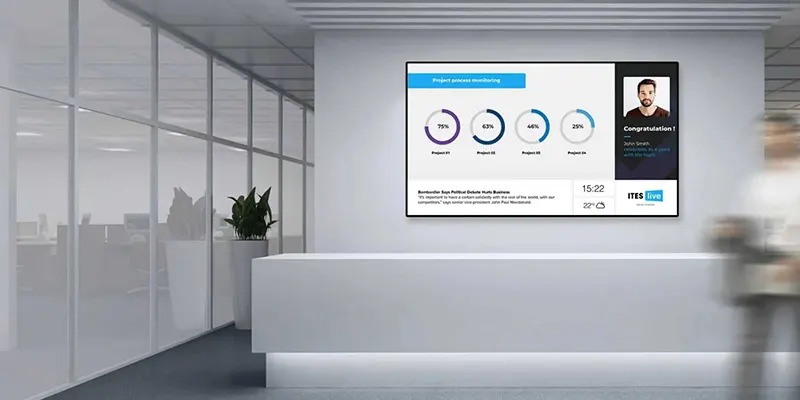What Is the Best Digital Signage for Small Business?
Introduction to Digital Signage
If you're a small business owner looking for a powerful way to grab attention and deliver information effortlessly, digital signage is one of the smartest investments you can make. With screens becoming more affordable and software easier than ever to use, digital signage has transformed from a luxury into an essential communication tool for businesses of all sizes.
But with so many choices available—LED screens, smart TVs, digital signage players, interactive touchscreens—how do you know which one is truly the best for your small business?
Let's break it down step by step so you can make a confident, well-informed decision.
Why Digital Signage Matters
Digital signage replaces static posters with dynamic, attention-grabbing screens. In an age where everyone is used to seeing engaging digital content, traditional print materials often feel outdated and easy to ignore.
Digital signage, however:
·Captures attention instantly
·Saves money on printing
·Allows real-time updates
·Helps create a modern, professional brand image
·Boosts customer engagement and sales
From menu boards to retail promotions, digital signage delivers information faster and more effectively compared to traditional methods.
Key Advantages for Small Businesses
Small businesses often operate with limited resources, which makes efficiency essential. Digital signage gives you the power to promote, educate, and engage—all from one platform.
·Cost-Effective Marketing
Instead of printing dozens of posters every month, you can update your screen with new promotions, prices, and announcements effortlessly.
·Instant Updates
Sale starting today? New product arrived? Change it digitally in seconds.
·Enhanced Professionalism
Digital screens instantly make your business look more modern and credible.
·Stronger Customer Engagement
People are naturally drawn to movement. Video, animations, and vibrant graphics capture attention far more effectively than static signage.
·Increased Sales
Studies show digital signage can increase impulse purchases and customer awareness by up to 30%.
Types of Digital Signage for Small Business
Depending on your industry and goals, different types of digital signage may suit your needs. Here are the most popular options:
·Standalone Digital Signage Players
These small devices connect to any display screen and run your content via USB, HDMI, or cloud software. They're: Affordable / Easy to install / Reliable for continuous use
Perfect for: shops, restaurants, gyms, and salons.
·Smart TVs with Built-in Signage
One of the most budget-friendly solutions. Many smart TVs support signage apps or USB content loops.
Ideal for: small restaurants, start-up retailers, offices, waiting areas.
·LED Display Boards
Bright and visible from a distance, LED displays are great for outdoor advertising or grabbing attention from the street.
Best for: storefront advertising, window displays, outdoor promotions.
·Interactive Touchscreen Displays
Touchscreens allow customers to explore menus, browse product catalogs, or access information on their own.
Used in: kiosks, restaurants, service centers, hotel lobbies.
Key Features to Look For
Before investing in digital signage, consider the must-have features to ensure your setup works smoothly.
Content Management System (CMS): A CMS lets you upload, organize, and schedule content. It is the heart of your signage system.
·Cloud-Based CMS
·Access content from anywhere
·Multi-screen management
·Automatic updates
·Great for businesses that frequently update promotions.
·Local/Offline CMS
·No internet required
·Simple to use
·More stable in remote locations
·Perfect for smaller shops without reliable Wi-Fi.
·Ease of Use
A beginner-friendly dashboard is essential. Look for:
·Intuitive Interface
The dashboard should be simple to navigate, even for users with no technical background. Clear icons, drag-and-drop editing, and straightforward menu organization help you quickly update content.
Easy Content Uploading: You should be able to upload images, videos, and menu items without complicated steps. A good system supports common file formats and lets you create attractive layouts with minimal effort.
·Real-Time Updates
A user-friendly dashboard allows you to publish changes instantly across all screens. This is useful for updating prices, adding new dishes, or launching time-limited promotions.
Ready-Made Templates: Look for built-in templates that make designing your digital menu fast and professional. Templates save time and help beginners create visually appealing menus without needing design skills.
·Clear Device Management
The dashboard should let you monitor connected screens, check their online status, schedule content, and manage playlists—all from one place.
·Multilingual Support
If your business serves diverse customers or your staff speaks different languages, a dashboard with multilingual support will make operation much easier.
·Cloud-Based Control
Choosing a cloud dashboard allows you to update your menus from anywhere, using a laptop or mobile device. This is perfect for business owners managing multiple locations.
How to Choose the Right Digital Signage
·Determine Your Purpose and Goals
Start by identifying what you want to achieve with digital signage—advertising, menu display, brand messaging, wayfinding, or customer engagement. Your purpose will guide your choice of screen size, software features, and installation type.
·Choose the Right Display Type
Different environments need different screens.
Indoor displays require high resolution and brightness levels suitable for indoor lighting.
Outdoor displays need weatherproof protection, high brightness (1,500–5,000 nits), and durable construction to handle sunlight, rain, and temperature changes.
Touchscreen displays are great for interactive menus, kiosks, or information boards.
·Consider Screen Size and Placement
Make sure the display is large enough and placed at an ideal height and angle so customers can see it easily. For example, larger screens work best for menu boards, while smaller screens suit shelf-edge displays or kiosks.
Conclusion
Digital signage is one of the most effective ways for small businesses to level up their marketing, improve customer engagement, and create a modern, professional atmosphere. With the right combination of hardware and software, even the smallest shop can deliver big-brand visuals.
Whether you're promoting products, sharing information, or improving customer experience, digital signage works 24/7—helping your business grow effortlessly.
Now that you know what to look for and how to choose, you're ready to pick the best digital signage solution for your unique business needs.
FAQs
1. Is digital signage difficult to set up?
Not at all. Most systems are plug-and-play with easy-to-use software.
2. How much does digital signage cost for small businesses?
Anywhere from $100 to several thousand, depending on your screen type and software plan.
3. Can I manage digital signage remotely?
Yes—if you choose cloud-based management software.
4. What screen size is best for small businesses?
Most small stores use 32"–55" displays, depending on space.
5. Does digital signage increase sales?
Yes. Dynamic visuals attract more attention and encourage impulse buying.


